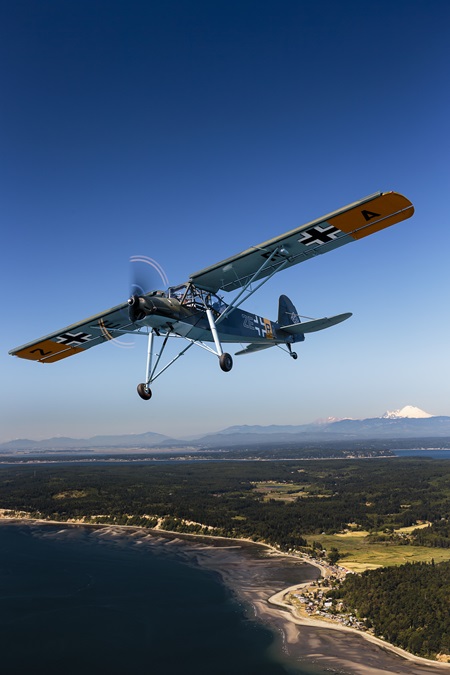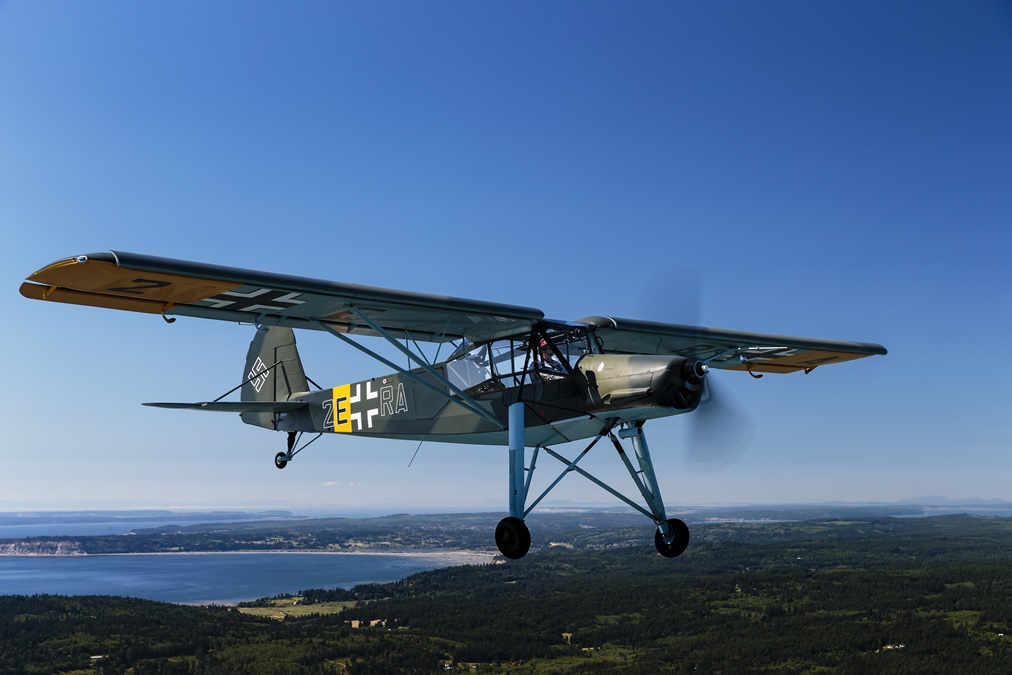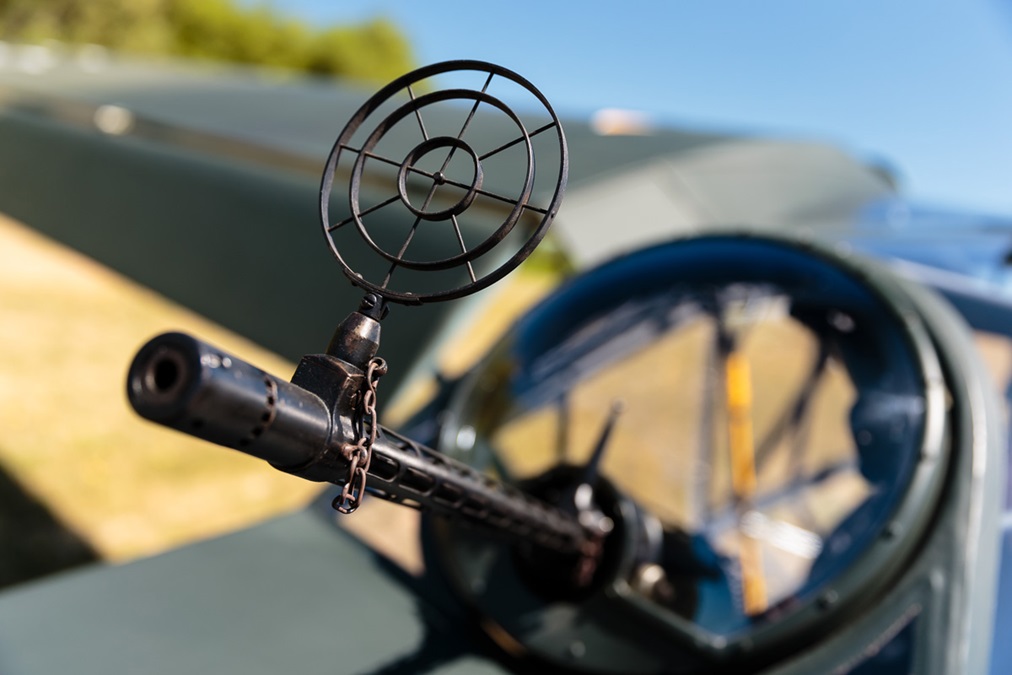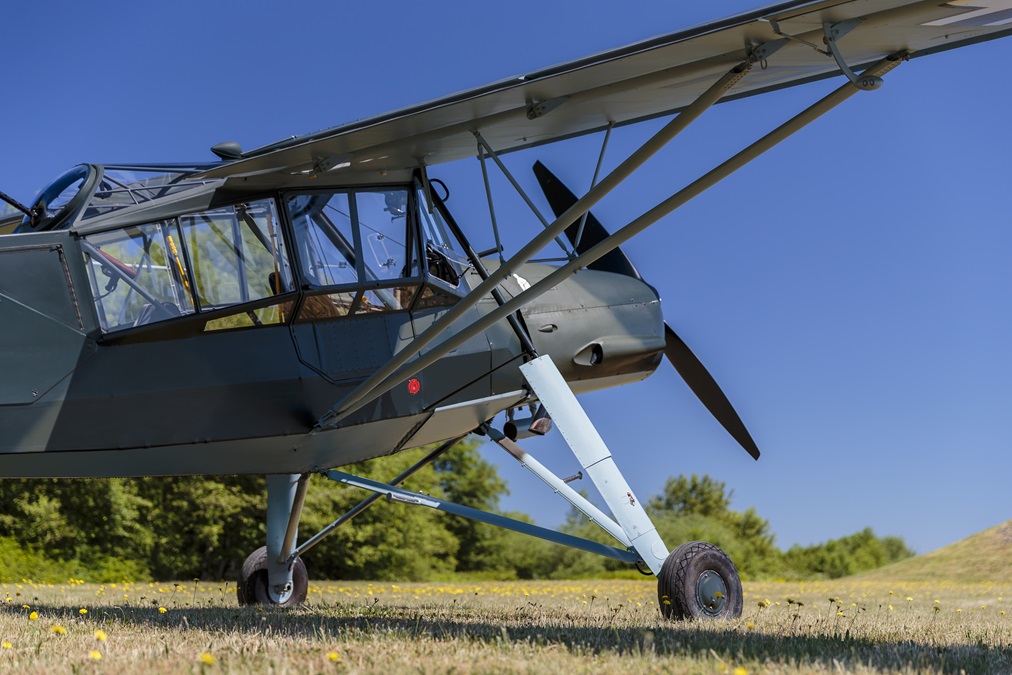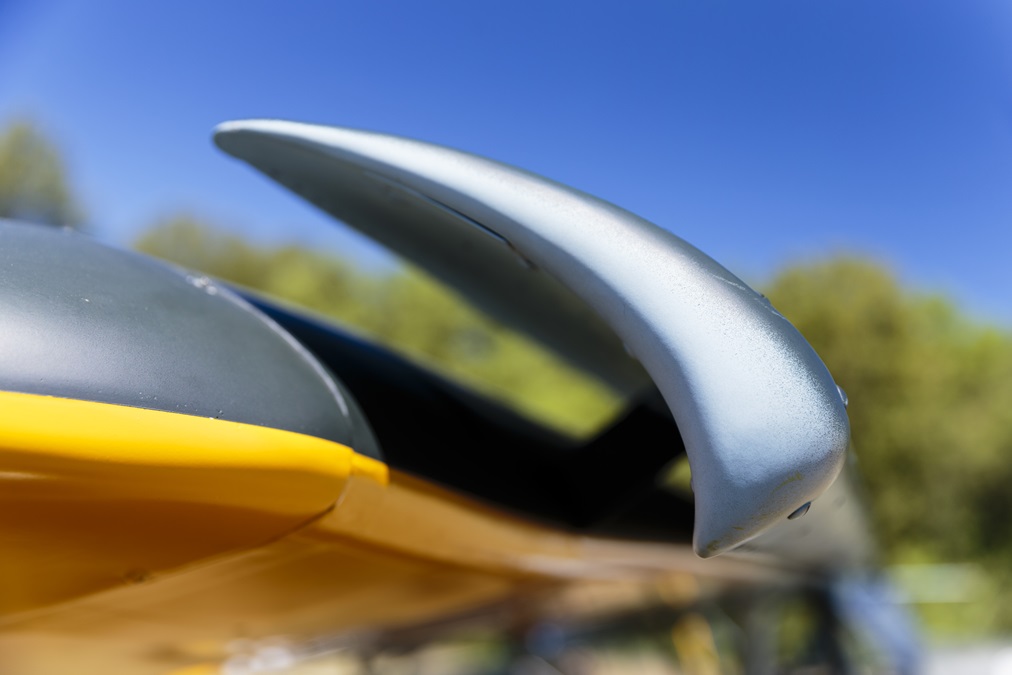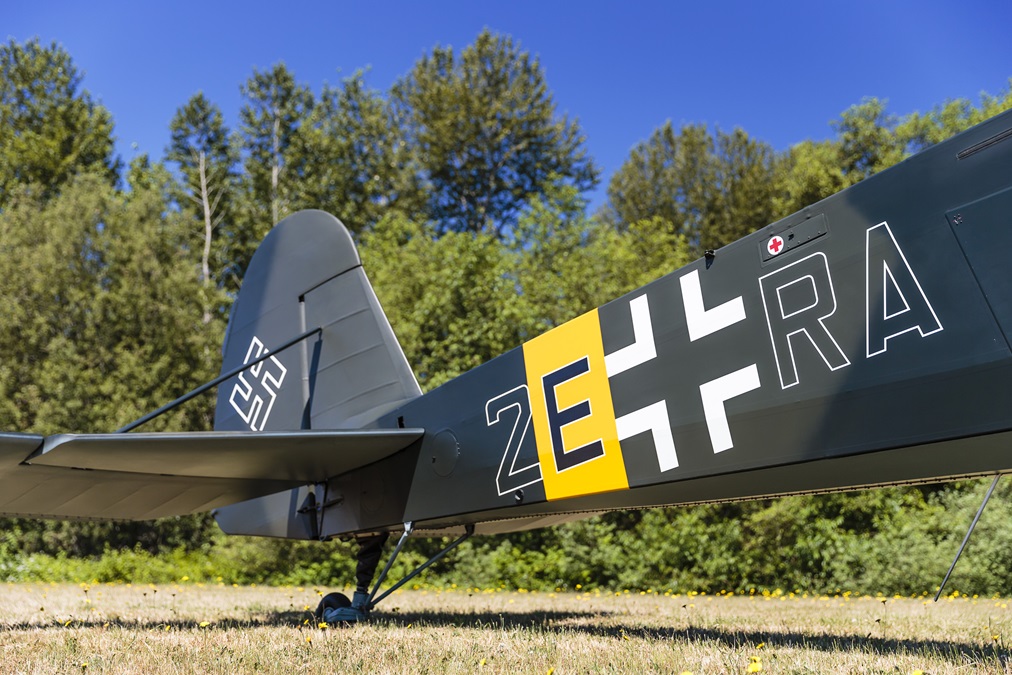The Luftwaffe's L-Bird
Long-legged Fieseler Storch alights in Washington
The airplane was the brainchild of Gerhard Fieseler, a four-time German ace in the Great War. He later developed inverted fuel and oil systems; was first to fly inverted for a sustained period of time; and became the 1934 world aerobatic champion in an airplane of his own design. He is credited with being first to perform a hammerhead turn (also called a Fieseler).
The Storch first flew on May 24, 1936, and nearly 3,000 were delivered to the Luftwaffe between 1936 and 1944. One landed on an Alpine slope at an elevation of 9,000 feet to liberate Italian dictator Benito Mussolini from mountaintop imprisonment in September 1943. Test pilot Hanna Reitsch flew a Storch into Berlin shortly before V-E Day with the hope of rescuing Adolf Hitler from a city under siege by the Allies. A Storch was the last victim of a World War II dogfight. Using .45-caliber pistols, the American pilots of a Piper L–4 (essentially a J–3 Cub) forced the Fieseler to land and its pilots to surrender.
So impressed was Ryan Aeronautical with the Storch’s short-field performance that it attempted in 1940 to develop a competitive airplane, but the Ryan YO–51 Dragonfly did not match the Storch’s extraordinary slow-flight capability.
The subject of this report, N436FS, was built in 1943 and flown by the Luftwaffe in occupied Europe and on the Russian Front. It eventually was discovered as an abandoned basket case in East Germany and became one of five that were meticulously restored by the Fieseler Corp. of Canton, Michigan. It was purchased in December 2000 by Microsoft cofounder Paul Allen for his Flying Heritage Collection of World War II aircraft at Paine Field in Everett, Washington. Founded in 1990, the collection is open to the public.
The Storch is larger than you might expect and sits high on stilt-like landing-gear legs. They incorporate long-stroke, oleo-type shock absorbers that can withstand enormous loads and soften landings made on irregular surfaces at high sink rates. (The tailwheel also has an oleo strut.) The tires, however, seem incongruously small for an airplane operated from rough landing areas.
Heavy-duty inspection zippers allow easy access to the aft interior of the fabric-covered, tubular-steel fuselage. This is much more revealing than peering through the small holes left after removing the inspection plates found on most fabric-covered airplanes. The 47-foot-long wings are made of wood and have fixed, full-span slats along their leading edges that contribute significantly to the Storch’s astounding slow-flight performance. The wings can be folded rearward and flush alongside the fuselage, like those of a Grumman F4F Wildcat, to facilitate ground transportation and storage.
The Storch has only one set of flight controls, so getting checked out in one involves an unusual protocol. Flying Heritage Collection pilot Jason Muszala led me to the back seat and then took me on a flight to demonstrate the low-speed edges of the performance envelope and familiarize me with what to expect when I would be alone. Back on the ground, he gave me a thorough cockpit checkout. After swapping seats, Muszala talked me through an engine start and then observed my handling of the airplane while taxiing. After that, he got out and sent me on my way to solo the airplane for the first time.
The Storch carries two in tandem, but a third emergency seat in the rear could be used by a gunner to defend the airplane using a 7.92-mm machine gun, which could be mounted at the rear of the cabin.
Climbing up and into the front seat takes a bit of effort, but once inside, long-legged pilots discover that the rudder pedals are way too close. My legs were bent more and my knees were positioned higher than in any other airplane I have flown. Complicating this anatomical difficulty is that you cannot rest your heels on the floor and move the pedals with the balls of your feet. You instead position your feet flat on the pedals at an awkward angle so that your heels fit into curved rests, or lips, on the bottoms of the pedals. You then push each pedal using the entire foot—an arrangement that made me susceptible to inadvertently applying the toe brakes at inappropriate times. An adjustable seat or adjustable rudder pedals would have made conditions much more comfortable. There is, however, ample shoulder and head room.
Engine start is challenging because all instruments, switches, and controls are labeled in German. For example, vertical speed is shown as Steigt (climb) and Sinkt (sink) in meters per second, the tachometer is labeled U/min (rpm), the airspeed indicator is labeled Fahrt (speed) and reads in kilometers per hour, the Höhenmesser shows altitude in kilometers, and so forth. At least the fuel selector is labeled L-R, but this is not for Left-Right—it stands for Links-Rechts. Many of the switches and levers are completely unfamiliar in appearance. No wonder legendary pilot Bob Hoover had to put a pistol to the head of a German mechanic to start the engine of the Focke-Wulf Fw 190 in which he escaped from Nazi Germany during World War II.
The Storch does not have an electric fuel pump but instead has two engine-driven pumps and a wobble pump to manually build pressure for starting. The 240-horsepower Argus AS 10C-3 air-cooled, inverted V-8 engine turns a wooden, 102-inch Schwarz propeller. These engines reputedly run hot, which explains why vintage photos of the Storch often show them flying with their side cowl panels removed.
The steerable tailwheel is not all that steerable. After applying full rudder in the direction of turn, you often need to apply same-side braking to obtain a decent turn radius. Some power is then used to assist in “ruddering” through the turn. It reminded me of taxiing an airplane with a tailskid.
The preflight runup includes checking the mags at 1,800 rpm, setting the adjustable horizontal stabilizer, and extending the slotted flaps to 15 degrees. The flaps may be fully extended to 40 degrees when operating from rough or short fields, or when departing over obstacles. They are operated by cranking a sprocket wheel on the left cockpit sidewall that drives an exposed bicycle chain, which positions the flaps. This action is reminiscent of what it was like to manually crank open and close windows on antique automobiles.
There is an interesting relationship between the flaps and the ailerons. As the flaps extend beyond 30 degrees, the ailerons begin to droop, reaching 15 degrees of droop as the flaps reach 40 degrees. The effective result is full-span flaps.
The mixture control is adjacent to the throttle on the left sidewall and operates backwards. Pull it aft for rich and push forward for lean. When retarding the throttle, a small horizontal extension on the throttle arm also pulls the mixture control aft (rich) to ensure that you don’t inadvertently land lean.
Takeoff happens quickly. The tail rises slightly as you advance the throttle, and the airplane leaps off the ground before you have much chance to think about it. Zero-wind ground roll at a maximum gross weight of 2,780 pounds is as little as 180 feet, less than the distance between two runway lights. Best rate of climb speed is 45 mph, and normal climbs are made at 55 mph.
When on the ground, you can look out the side windows and see the main wheels. After liftoff, however, the wide-spread, hinged landing-gear legs fall almost straight down, and the wheels no longer can be seen. With the gear legs hanging in this manner, the airplane resembles its namesake, the stork. When touching down, the gear legs spread to re-enlarge the wheel base.
Cockpit visibility is outstanding through 30 thermoplastic windows that give the feeling of being in an airborne greenhouse. The outward-angled windows near your elbows allow looking straight down on both sides of the aircraft, an excellent feature for its reconnaissance mission. The greenhouse effect of increasing cockpit temperature is dramatic. Flying a Storch for German Field Marshal Erwin Rommel in the North African theater during the 1944 Saharan summer must have been like sitting in a sauna.
The ailerons have servo tabs to reduce roll forces, but larger tabs or stronger pilots are needed. The long wings create significant roll damping, resulting in a heavy control stick and a sluggish roll rate. Both hands are needed on the stick to rush into and out of turns. Combining this with the Storch’s light wing loading and lack of dihedral makes the airplane a handful in turbulence.
The Storch has a large rudder, and you need it—especially when coordinating turn entry and recovery during slow flight. Although heavy and sluggish, the ailerons nevertheless remain effective even when the aircraft is in a near-stall condition. You can maintain complete control of the airplane at a calibrated airspeed of only 31 mph, although the Fahrt gauge indicates near zero.
Recovery from power-on stalls in a Storch is conventional, but an excellent piece of advice is to avoid power-off stalls, which is completely opposite to what you might expect. A power-off stall requires an extremely nose-high attitude, and with so little airspeed, the controls lose the effectiveness needed to prevent the airplane from rolling onto its back. During a power-on stall, there is sufficient propwash across the tail surfaces to effect recovery from the stall.
The Storch was not built for speed. Normal cruise at 3,280 feet msl (one kilometer) is only 93 mph. Maximum cruise at sea level is 109 mph. The 39.6 gallons of fuel in the wing tanks provide a no-reserve range of 248 miles, or several hours of low-power loitering.
Interestingly, the airplane glides best (at 56 mph) with the flaps lowered to 15 degrees. You approach the runway and cross the fence at 43 mph. Touchdown typically occurs at 32 mph (only 28 knots). You can go around and climb safely with the flaps fully extended.
A three-point or so-called full-stall landing is better described as a full-mush landing. You can actually feel the rapid drag rise and developing sink rate early in the flare. To avoid premature touchdown, you need to pull the stick back aggressively and fully. The long-stroke oleos then squish and the gear legs spread as the airplane settles onto the ground at what seems like a standstill. The landing sequence is much like a large bird alighting on a rock, its great wings extended and angled to catch the wind. You can land in as little as 246 feet. If ever there were a flying speed brake, the Fieseler Storch would be it. It lands on a dime and gives a nickel change.
The mixture control does not have an idle-cutoff position. The engine is shut down by turning off the fuel supply to the pumps, and then waiting a minute or so for the engine to tick to a stop.
Paul Allen says that his fascination with World War II airplanes began when he built models of them during boyhood. “I began to collect actual aircraft partly as a tribute to my father, who landed on Omaha Beach and subsequently was awarded a Bronze Star and a battlefield commission,” he says. “Our vintage warplanes represent the primary combatants of the war and are intended to pay homage to the sacrifice, bravery, and heroism of those who answered the call to serve their country. All are fully restored and most are kept airworthy so that the public can experience their power and majesty as they fly over and around the airport on scheduled Fly Days.”
Although there is nothing powerful or majestic about the Storch, it is a fascinating airplane to fly—or to watch being flown. More about Allen’s collection can be found online.
Web: www.barryschiff.com

